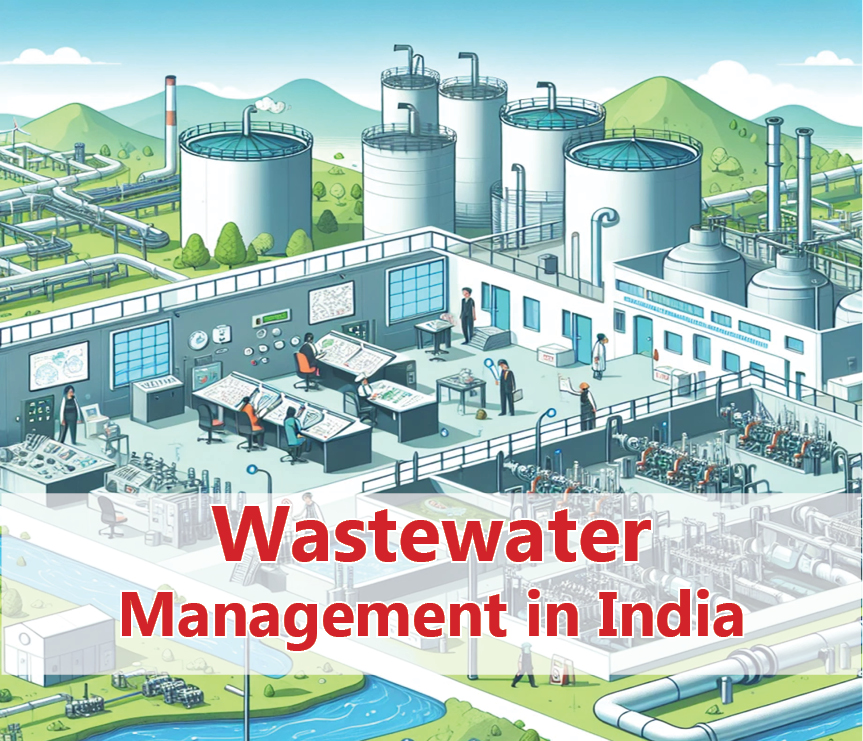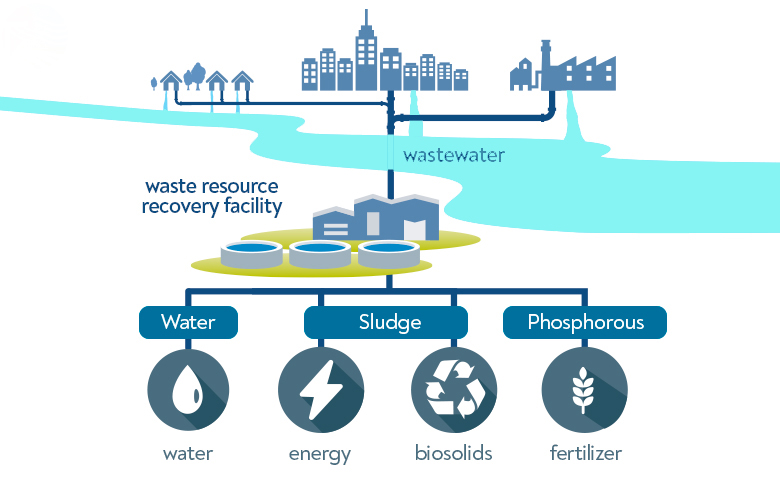Context:
Water is the basis of life. It sustains our health, feeds our farms, powers industries, and keeps natural ecosystems alive. Yet, despite being so central, water is fast becoming one of the biggest challenges of the 21st century.
-
- One promising solution is to look at wastewater differently, not just as waste to be disposed of, but as a resource to be treated and reused. Particularly in India’s water-stressed urban areas, wastewater treatment and reuse could play a major role in bridging the growing gap between demand and supply.
- One promising solution is to look at wastewater differently, not just as waste to be disposed of, but as a resource to be treated and reused. Particularly in India’s water-stressed urban areas, wastewater treatment and reuse could play a major role in bridging the growing gap between demand and supply.
Wastewater in India: Scale and Sources:
From 1951 to 2024, the amount of surface water available per person in India has gone down by 73%. Indian cities produce over 72,000 million litres of sewage every day, according to the Central Pollution Control Board (CPCB). But the treatment plants can handle less than 32,000 million litres a day. In reality, only 28% of city wastewater is treated. The remaining 72% flows untreated into rivers, lakes, and land, causing severe environmental and health hazards.
Major sources of wastewater:
1. Domestic sewage – The largest contributor. For example, the Yamuna receives 641 MLD of untreated sewage daily, making it ecologically dead in parts.
2. Industrial effluents – India has over 3,500 highly polluting industries discharging effluents into rivers. Tanneries in Kanpur and distilleries in Bihar are major contributors to Ganga basin pollution. These effluents often contain heavy metals, dyes, and toxic chemicals.
3. Agricultural run-off – Fertilisers and pesticides add excess nutrients (nitrogen and phosphorus), causing eutrophication in lakes and rivers. Vembanad Lake in Kerala, a Ramsar site, has seen fish populations decline due to nutrient pollution.
Impacts of Wastewater Mismanagement:
Wastewater is not just an environmental issue but also a serious public health and economic concern.
-
- Health risks – Contaminated water spreads waterborne diseases such as diarrhoea, cholera, and dysentery. Nearly 37.7 million Indians are affected annually. It also contributes to anti-microbial resistance (AMR).
- Economic impacts – Increases costs of potable water treatment and affects sectors like fisheries, agriculture, and tourism.
- Environmental impacts – Leads to river pollution, groundwater contamination, biodiversity loss, and ecological degradation.
- Health risks – Contaminated water spreads waterborne diseases such as diarrhoea, cholera, and dysentery. Nearly 37.7 million Indians are affected annually. It also contributes to anti-microbial resistance (AMR).
Legal and Policy Framework for Wastewater Management:
Legal Provisions
-
- Water (Prevention and Control of Pollution) Act, 1974 – India’s first comprehensive water pollution law. It established the CPCB and State Pollution Control Boards (SPCBs) with powers to set effluent standards and monitor compliance.
- Environment Protection Act, 1986 – Provides an umbrella framework for environmental regulation, including water.
- Water (Prevention and Control of Pollution) Act, 1974 – India’s first comprehensive water pollution law. It established the CPCB and State Pollution Control Boards (SPCBs) with powers to set effluent standards and monitor compliance.
Policy Framework
-
- National Water Policy, 2012 – Recognised the importance of wastewater recycling and reuse as part of integrated water resource management.
- River Rejuvenation Programmes – Namami Gange and other projects target critical polluted river stretches.
- Urban Missions –
- Swachh Bharat Mission (SBM) – Promotes sanitation and wastewater management.
- AMRUT and Smart Cities Mission – Include sewage infrastructure and wastewater reuse facilities.
- Swachh Bharat Mission (SBM) – Promotes sanitation and wastewater management.
- National Water Policy, 2012 – Recognised the importance of wastewater recycling and reuse as part of integrated water resource management.
Recent Developments
-
- Draft Liquid Waste Management Rules, 2024 – Issued under the EPA, these rules emphasise:
- Waste minimisation
- Efficient collection and treatment
- Reuse of treated wastewater and sludge
- Alignment with the circular economy approach, viewing wastewater as a resource rather than a liability.
- Waste minimisation
- Draft Liquid Waste Management Rules, 2024 – Issued under the EPA, these rules emphasise:
However, implementation challenges remain. Only 11 out of 28 states have wastewater reuse policies, most without clear roadmaps. Weak enforcement, lack of infrastructure, and fragmented governance reduce impact.
Current Water Governance Framework:Constitutional Provisions
Institutional Framework
|
Technological Interventions in Wastewater Treatment:
Conventional Technologies
-
-
- Activated Sludge Process (ASP) – Aerobic method using microorganisms to treat sewage. Widely used but energy-intensive.
- Up-flow Anaerobic Sludge Blanket (UASB) – Cost-effective and energy-efficient, suitable for sewage but less effective for complex effluents.
- Activated Sludge Process (ASP) – Aerobic method using microorganisms to treat sewage. Widely used but energy-intensive.
-
Advanced Technologies
-
-
- Sequential Batch Reactor (SBR) – Operates in cycles, flexible but requires constant monitoring. Widely used in urban sewage treatment.
- Membrane Bioreactor (MBR) – Combines biological treatment and membrane filtration, producing high-quality effluent. Ideal for industrial and high-value urban areas but costly.
- Emerging Solutions – Nanotechnology-based filters, decentralised treatment plants, constructed wetlands, and waste stabilisation ponds.
- Sequential Batch Reactor (SBR) – Operates in cycles, flexible but requires constant monitoring. Widely used in urban sewage treatment.
-
Key Challenges in Wastewater Management
1. Low operational capacity – STPs operate at around 26,000 MLD, below their installed 31,000 MLD capacity.
2. Poor sewage infrastructure – Lack of sewer networks, mixing of domestic and industrial waste, and inadequate collection systems.
3. Weak governance – Limited coordination across central, state, and local bodies; fragmented responsibilities.
4. Financial constraints – High cost of advanced treatment plants, limited investment models.
5. Equity concerns – Informal and unplanned settlements are often excluded from wastewater infrastructure.
6. Public perception – Resistance to reuse of treated wastewater, especially for agriculture and daily use.
Way Forward:
Governance Reforms
-
-
- Stronger regulatory enforcement and monitoring.
- Local-level by-laws to support wastewater management.
- Clear institutional responsibilities with accountability mechanisms.
- Stronger regulatory enforcement and monitoring.
-
Financing and Partnerships
-
-
- Public-Private Partnerships (PPPs) for funding and operating STPs.
- Innovative financing models to sustain O&M costs.
- Public-Private Partnerships (PPPs) for funding and operating STPs.
-
Technological Upgradation
-
-
- Adoption of SBR and MBR in urban areas where high-quality reuse is needed.
- Low-cost, decentralised solutions like wetlands and stabilisation ponds in peri-urban and rural areas.
- Adoption of SBR and MBR in urban areas where high-quality reuse is needed.
-
Social Equity and Awareness
-
-
- Ensuring access to wastewater infrastructure in informal settlements.
- Awareness campaigns to build trust in safe reuse, especially in agriculture.
- Ensuring access to wastewater infrastructure in informal settlements.
-
Integrated Approach
-
-
- Aligning wastewater reuse with circular economy principles.
- Combining regulation, technology, financing, and social acceptance to transform wastewater from a liability into a resource.
- Aligning wastewater reuse with circular economy principles.
-
Conclusion:
India stands at a critical juncture in its water management journey. With rising scarcity, growing urbanisation, and climate stress, wastewater management is no longer optional but a necessity. While legal frameworks and policies exist, effective implementation, technological innovation, and strong governance will determine outcomes.
Treated wastewater, if managed well, can become a key resource for sustainable growth, reducing freshwater demand, supporting agriculture, and maintaining ecological balance. Moving towards a future where wastewater is valued as a resource will not only strengthen water security but also support India’s long-term environmental and developmental goals.
| UPSC/PSC Main Questions: “Water scarcity in India is as much a governance challenge as it is an environmental one.” Examine this statement in the context of wastewater management. |








